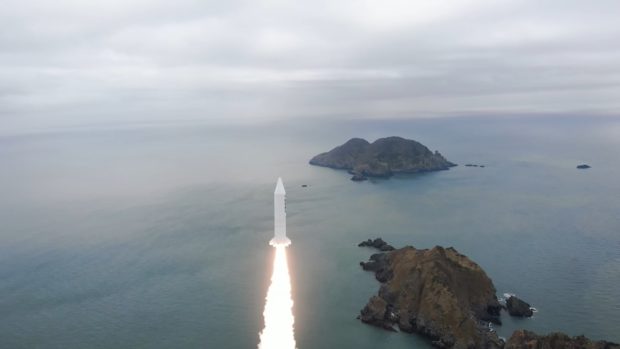
outh Korea launches a homegrown solid-fuel space rocket for the first time Wednesday at a testing site of the Agency for Defense Development located in Taean, South Chungcheong Province. (Ministry of National Defense via The Korea Herald/Asia News Network)
SEOUL — South Korea “successfully” test-launched a homegrown solid-fuel space rocket for the first time, taking one significant step to further develop and launch microsatellites for military surveillance and reconnaissance.
The state-run Agency for Defense Development said it conducted the test-firing to “verify the performance” of the solid-propellant carrier rocket developed with indigenous technologies on Wednesday at its own testing site in Taean, South Chungcheong Province. South Korean Defense Minister Suh Wook and other senior military officials were present.
The test aimed to “verify core technologies for space launch vehicles,” including large-scale rocket propellants, payload fairing and stage separation mechanisms, and upper stage attitude control system, according to the ADD.
South Korea has intensively pushed forward with developing space launch vehicles using solid fuel since South Korea and the US last May agreed to terminate missile guidelines that had put restrictions on the country’s missile development program since 1979.
Wednesday’s initial test launch came around eight months after the country carried out an “ignition test” for a solid-propellant rocket engine last July.
In comparison to liquid-propellant rockets, solid-fuel carrier rockets have the advantages of a simple structure and convenient manufacturing. Solid rockets can be manufactured and developed with lower costs and “launched quickly.”
South Korea in October conducted the first test launch of a homegrown liquid-propellant Nuri rocket, but it has failed to put its payload into the targeted orbit after liftoff.
Path to develop spy satellites
The current development is of paramount significance, given that it is in line with Seoul’s efforts to develop the military’s intelligence, surveillance, and reconnaissance capabilities.
The South Korean military has relied on the US ISR assets as it has not yet independently launched a spy satellite capable of monitoring North Korean activities.
But Seoul has said it will put micro or ultra-microsatellites for military purposes into a low Earth orbit by using a solid carrier rocket and employing relevant technologies.
“A satellite mounted on a solid-propellant space launch vehicle will be launched after completing additional verification,” the state-run arms development agency said in a statement.
“The launch is expected to lead to the development of space launch vehicles that can put microsatellites or ultra-micro satellites into a low Earth orbit.”
South Korea plans to launch a homegrown solid-propellant rocket at the Naro Space Center in Goheung, South Jeolla Province after the ADD verifies and integrates major components.
Two Koreas in arms race
Wednesday’s announcement is noteworthy given that the Moon Jae-in government has largely refrained from making public South Korea’s weapons tests and development.
But this time, the ADD conspicuously highlighted the significance of the solid rocket test-firing which was conducted at a juncture when North Korea has pushed forward its plan to develop technologies for space and missile systems.
North Korea’s two missile launches on Feb. 27 and March 5 involved a new Hwasong-17 intercontinental ballistic missile system. Pyongyang has claimed that it test-fired a Hwasong-17 ICBM on a lofted trajectory on March 24.
This month, North Korean leader Kim Jong-un also said the country will launch “a large number of military reconnaissance satellites” by 2025 to monitor the military activities of the US forces and its allies in the region.
The ADD on Wednesday underscored that the test launch was conducted at a “very critical time when North Korea launched an ICBM contravening the moratorium of its own accord.”
“Therefore, the successful test-firing of a solid-propellant space launch vehicle marks an important milestone in strengthening national defense capabilities,” especially in respect to the South Korean military’s “independent space-based surveillance and reconnaissance” capabilities.
“Our military will expeditiously advance space power, including a solid-propellant rocket, based on cross-service cooperation with the recognition that space is the key domain that has a significant impact on our national security.”
Focus on low-earth-orbit satellites
South Korea’s arms procurement agency on Wednesday announced its plan to “accelerate the space-based surveillance and reconnaissance system” as the battlefield has been expanded to space.
The Defense Acquisition Program Administration said it has established and confirmed its grand strategy and direction to “achieve superiority on the future battlefield” at a first meeting of the Advanced Defense Technology Programs Management Committee held on the same day.
As a key outcome, Seoul has decided to focus on developing and putting low-earth orbit or LEO satellites into an orbit below the altitude of 500 kilometers, which can be operated with low maintenance costs.
“Through the development, our military can acquire quasi-real-time surveillance and reconnaissance capabilities at a low cost and satellite communications capabilities with shorter delay and higher reliability compared to the existing satellites in high Earth orbit,” the DAPA said.
The military also plans to develop technologies that can put micro-satellites into a low Earth orbit by 2024, employing the solid-propellant rocket technologies developed by the ADD.
RELATED STORIES
S.Korea’s Moon vows ‘Korean space age’ after mixed rocket test results
Korea ups investment to self-produce parts in space development
North Korea says it conducted second ‘important’ spy satellite test